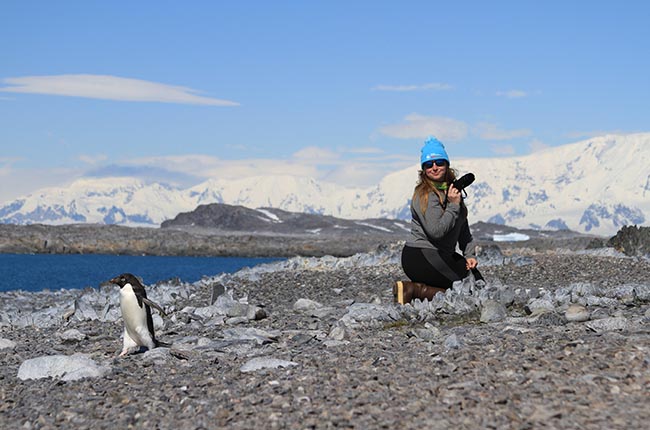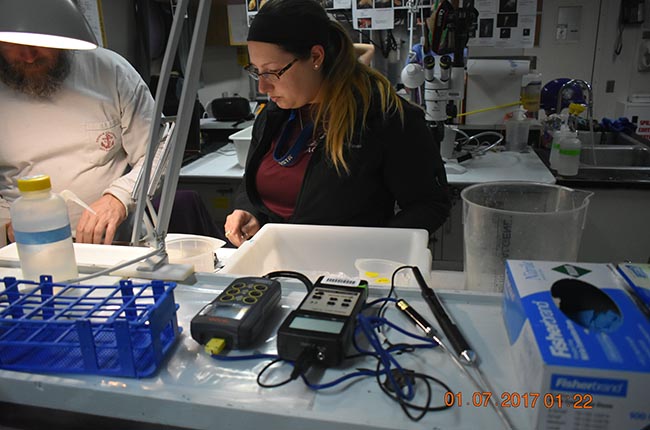Most undergraduate students rarely get a chance to do research in some of the world’s most remote locations alongside some of the top scientific minds, but a Texas A&M University at Galveston student is living the dream at the bottom of the world – Antarctica.
Katie Westmoreland, a senior with a double major in marine fisheries and marine biology, has been working with 22 other researchers on the icy continent for the past six weeks. The group was studying various topics ranging from climate change to ocean currents and marine diets and is part of the National Science Foundation’s Long Term Ecological Research project.
The Dayton, Texas native has packed in a full semester’s work with special attention to zooplankton such as krill – tiny organisms that are a whale’s favorite food source – and salps, another key item in the marine food chain.
“We have been looking at the Antarctic ecosystem, especially with what has happened over the last 25 years,” Westmoreland says.
“Ecological processes do not happen rapidly, so this long-term data set is important to understanding how each part of the food web interacts over time, and if climate change is playing a role. Krill and salps are two important parts of the food web and are easily influenced by temperature and sea ice coverage. Krill especially is a key food source for whales, penguins, and seals, so understanding their distribution and abundance helps us learn about other parts of the marine food web in Antarctica.”
Westmoreland says that climate change is occurring much more rapidly at the poles than in other parts of the world, and studying the temperature fluctuations and season declines in sea ice on the marine life in the area is critical.
She was working on board the research vessel Laurence M. Gould.
Antarctica is the most remote of all the continents and was not even discovered until 1820, when some Russian sailors stumbled upon it. The area was largely neglected for the rest of the century. Antarctica is nearly twice the size of Australia and despite its icy terrain, it is considered a desert – it averages only 8 inches of precipitation a year. It is also the coldest place on Earth: the lowest temperature ever recorded occurred on July 21, 1983 when it reached minus -128 degrees at Vostok Station.
The continent has been governed by the Antarctic Treaty System since 1959, with 38 countries participating in the treaty which prohibits military activities, mineral mining, nuclear explosions and nuclear waste. At any given time, there are 1,000 to 4,000 scientists conducting research on the continent. Its name literally means “opposite to the Arctic” or “opposite to the north.”
Though it is currently summer in Antarctica, Westmoreland says weather conditions are always a challenge. Her ship was stuck in some ice for several days before being knocked free and returning to somewhat of a normal schedule.
“This has been a wonderful opportunity for me,” Westmoreland adds.
“It’s been a thrill to work down there with some of the best scientists in the world. I am thankful for all the wonderful professors and the education I have received and this has been the experience of a lifetime.”
Also, a trip with a happy ending. It seems that her boyfriend – who happens to be one of the assistant engineers of the vessel she was on and also a Texas A&M-Galveston graduate – did not get cold feet despite the frigid conditions and proposed to her a few days ago, so marriage plans are in the works, along with a lot of scientific data to pour over.
Hurdles To Climate Change Action In Economics And Politics, Not Divided Science
###
Contact: Katie Westmoreland by email at ktmwestmoreland@yahoo.com or Bob Wright, Executive Director of Marketing and Communications, Texas A&M University at Galveston. Office: 409-740-4840, Cell: 713-586-9870 Email: WrightB@TAMUG.edu, or Keith Randall, News & Information, (979) 845-4644 or keith-randall@tamu.edu
About Research at Texas A&M University: As one of the world’s leading research institutions, Texas A&M is at the forefront in making significant contributions to scholarship and discovery, including that of science and technology. Research conducted at Texas A&M represented annual expenditures of more than $892.7 million in fiscal year 2016. Texas A&M ranked in the top 20 of the National Science Foundation’s Higher Education Research and Development survey (2015), based on expenditures of more than $866.6 million in fiscal year 2015. Texas A&M’s research creates new knowledge that provides basic, fundamental and applied contributions resulting, in many cases, in economic benefits to the state, nation and world. To learn more, visit http://research.tamu.edu.
For more news about Texas A&M University, see https://today.tamu.edu/.
Follow us on Twitter at https://twitter.com/TAMU






